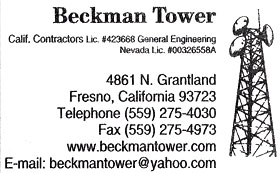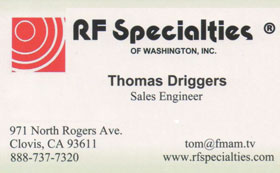I hope that some of you who were able to make the 2014 NAB will be at this months meeting to share the latest ‘gotta haves‘ with those of us who weren’t there. Our meeting presentation at the Clovis HomeTown Buffet will include two gentlemen who were at the Las Vegas bash, Tom Driggers of RF Specialties, and Ellis Terry of Nautel. They’ll be discussing the latest from their product lines at this hosted lunch event.
A reminder that if your SBE certification has lapsed you can still reinstate it without taking an exam. Check out the SBE Jubilee Project in the newsletter for details. Don’t delay, as the deadline is April 30, 2014.
The FCC keeps reminding us that they want EAS rules to be followed (check out the recent hefty fines). Here are some operational guidelines from Clay Freinwald, EAS Committee Chair.
ON THE RECEIVING SIDE –
- Everyone is assigned two stations to Monitor by the SECC
- You are to monitor those stations (you can monitor more if you wish).
- You cannot change those two sources on your own, this requires SECC Approval
- Yes, the FCC gives the SECC that authority.
- Your log is to show the reception of an RWT from both of those sources each week (Unless that week also contains an RMT or an actual use of the EAS as was the case with the Oso slide)
- If you fail to receive two RWT’s you are to log that fact and are also to log WHY you did not receive the test.
- Generally the procedure would be to contact others that are monitoring the same source to find out if they are receiving the tests (This information is contained in the Washington State EAS Plan Tab 10 for your Operation Area)
- If you find that others are not receiving these tests as well, it’s time to contact that source to see if they are indeed sending them. Sending an email to that source and not receiving a response is not going to get you off the hook…You have to actually make the effort to find out why they are not sending RWT’s….Even if this means making a phone call.
- In the end, you need to log the results of your research that will provide the reasons WHY you are not receiving the RWT’s.
ON THE TRANSMITTING SIDE –
- Your station MUST transmit an RWT each week (at random times in accordance with FCC Rules)
- Again ‘real’ use of the EAS can be substituted here
- If you find that your station has not been transmitting these tests, you need to find out why and log the results of that investigation.
SOME RECOMMENDATIONS –
- All stations should be checking the operation of their EAS Equipment, at least weekly, to avoid having a problem be repeated. Personally, I check these units I am responsible for, no later than each Tuesday.
- If your station sends the RWT’s Manually, and you find that you have an operator or personnel problem causing you to have an FCC EAS Rule compliance issue….Seriously consider having your
- EAS Encoder perform this task for you. You will likely annoy someone on your staff, however, it sure beats having the FCC issue an NOV or perhaps an NAL.
More information can be found in the FCC’s EAS rules (Part 11).
Hope to catch you at the upcoming April meeting, see you there.



